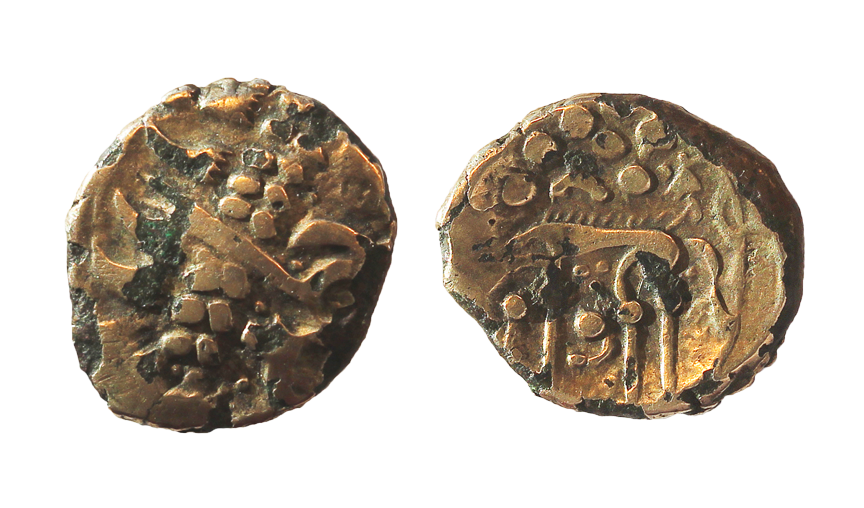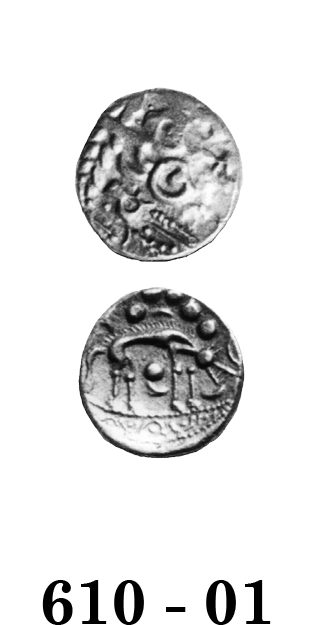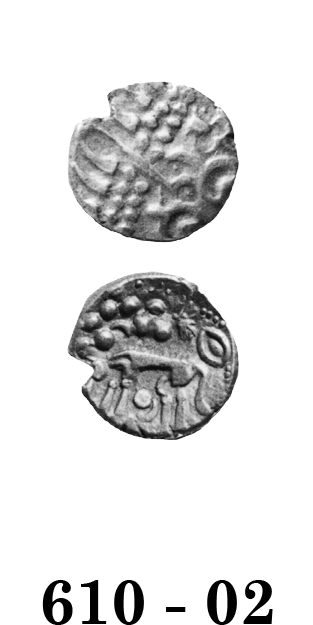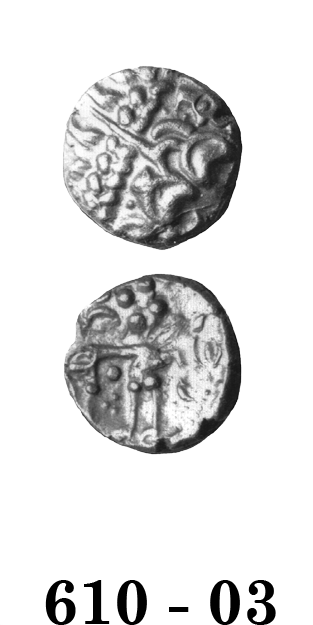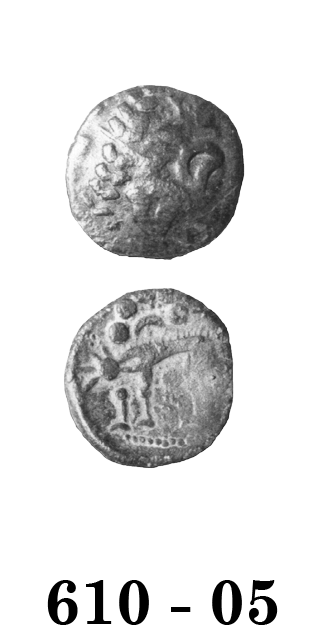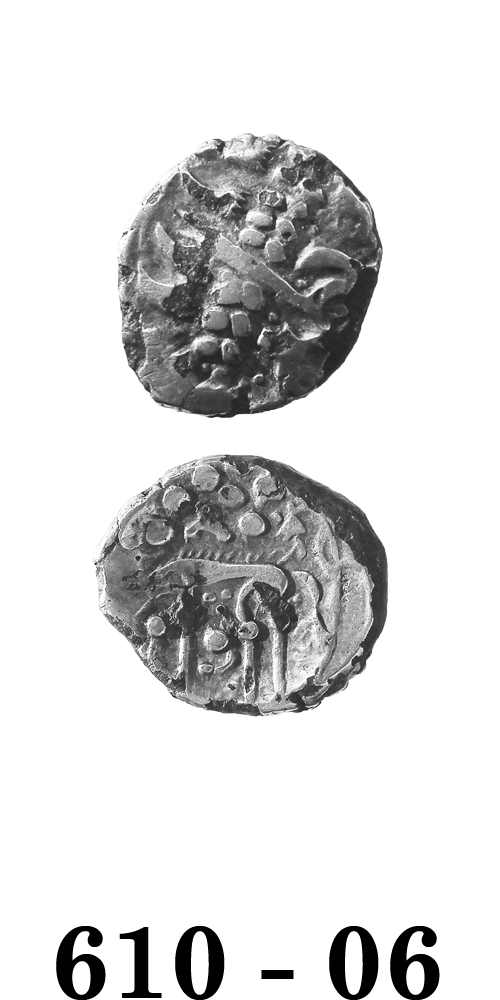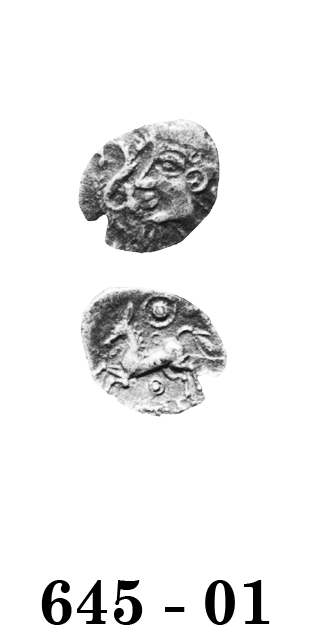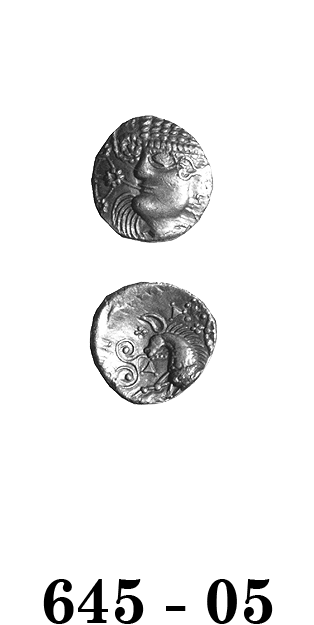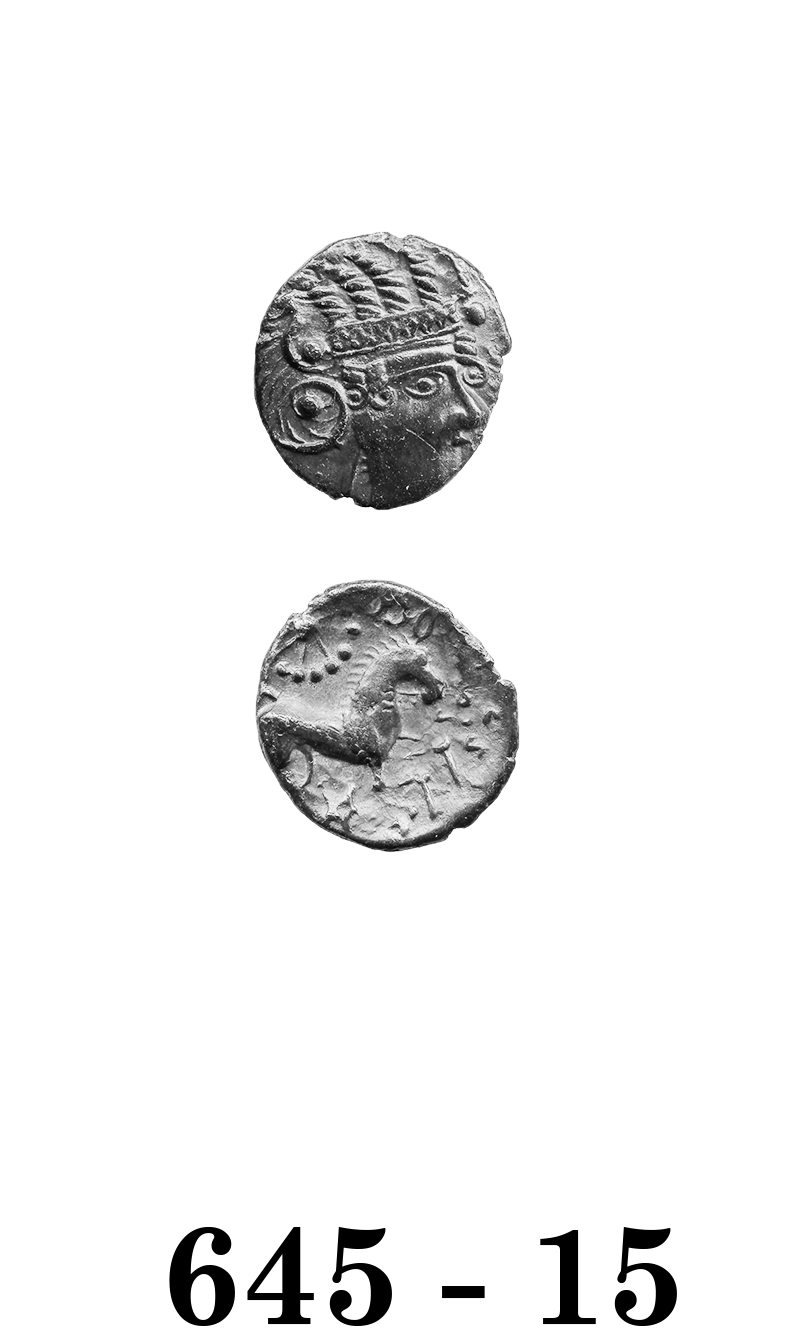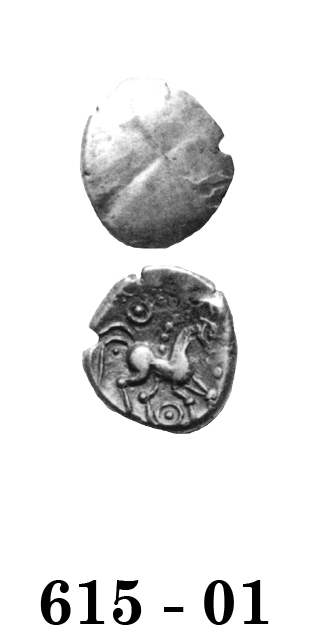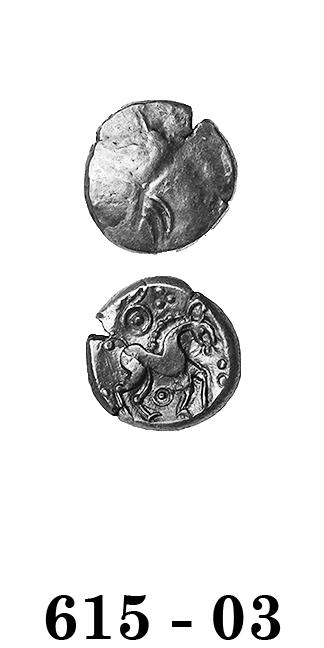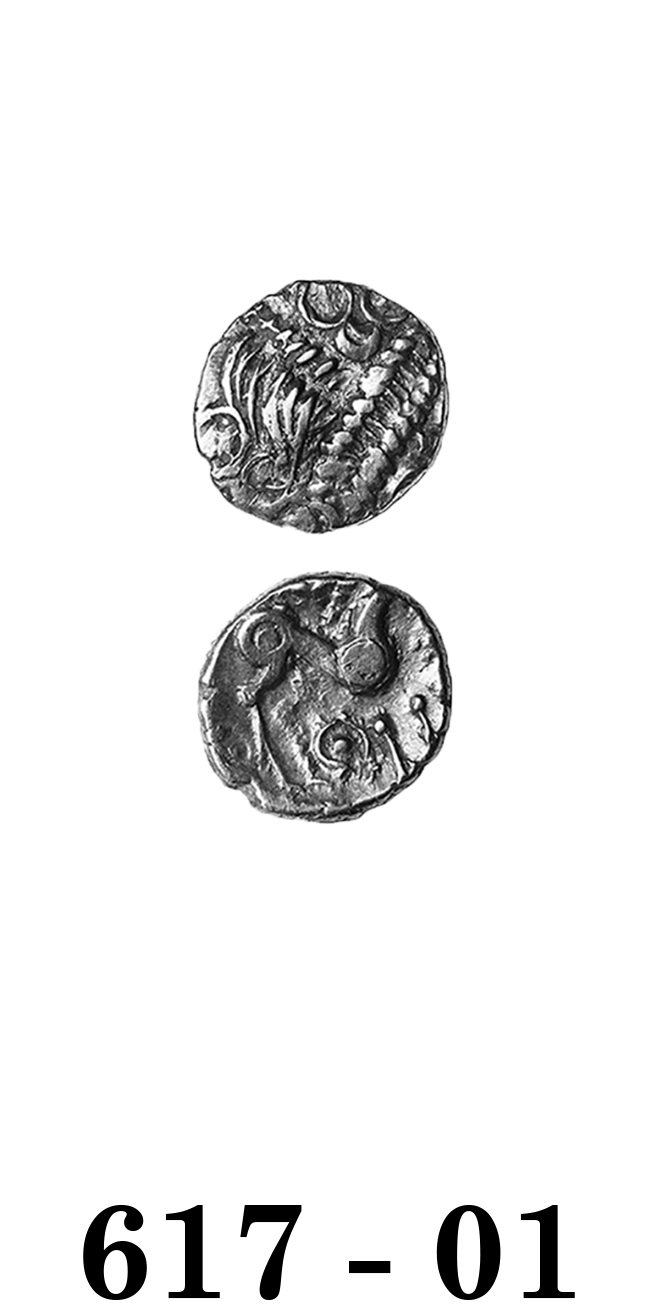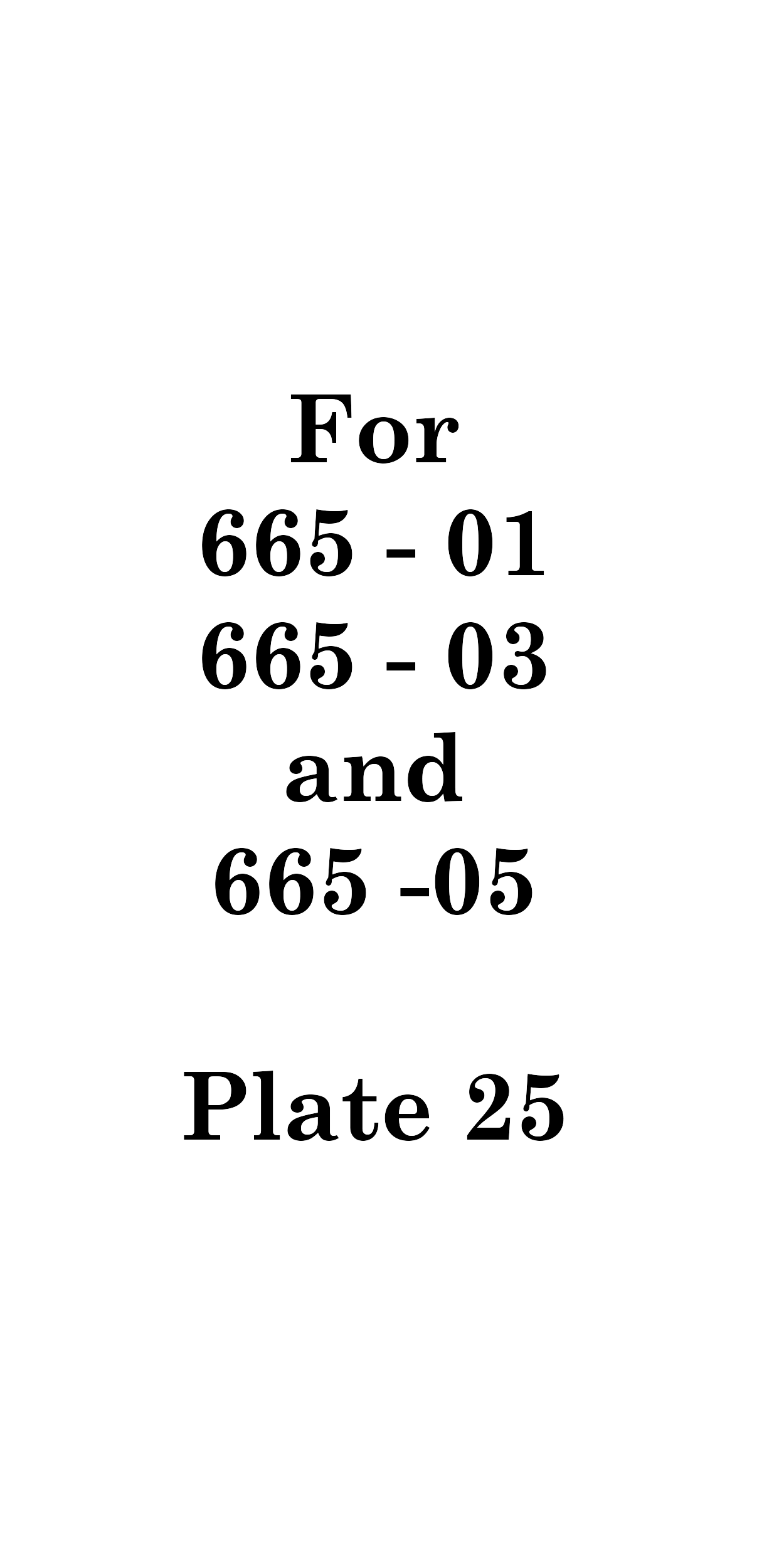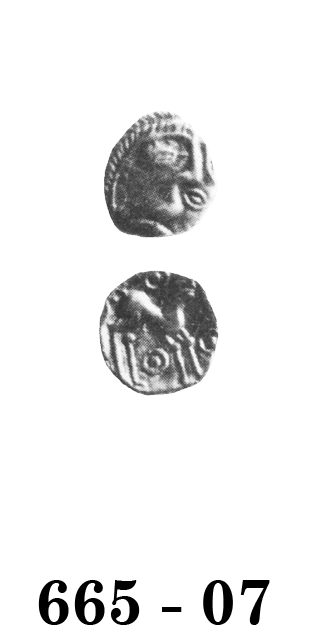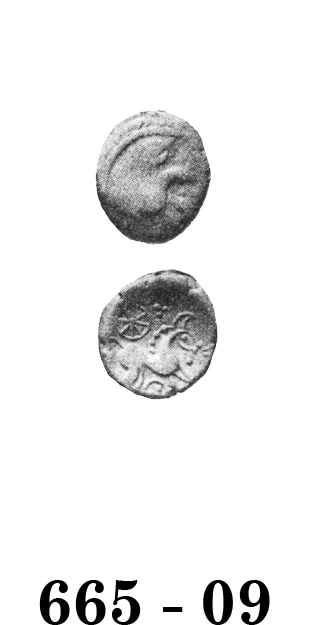
Celtic Coinage of Britain
third edition
Click on coin to see hidden information
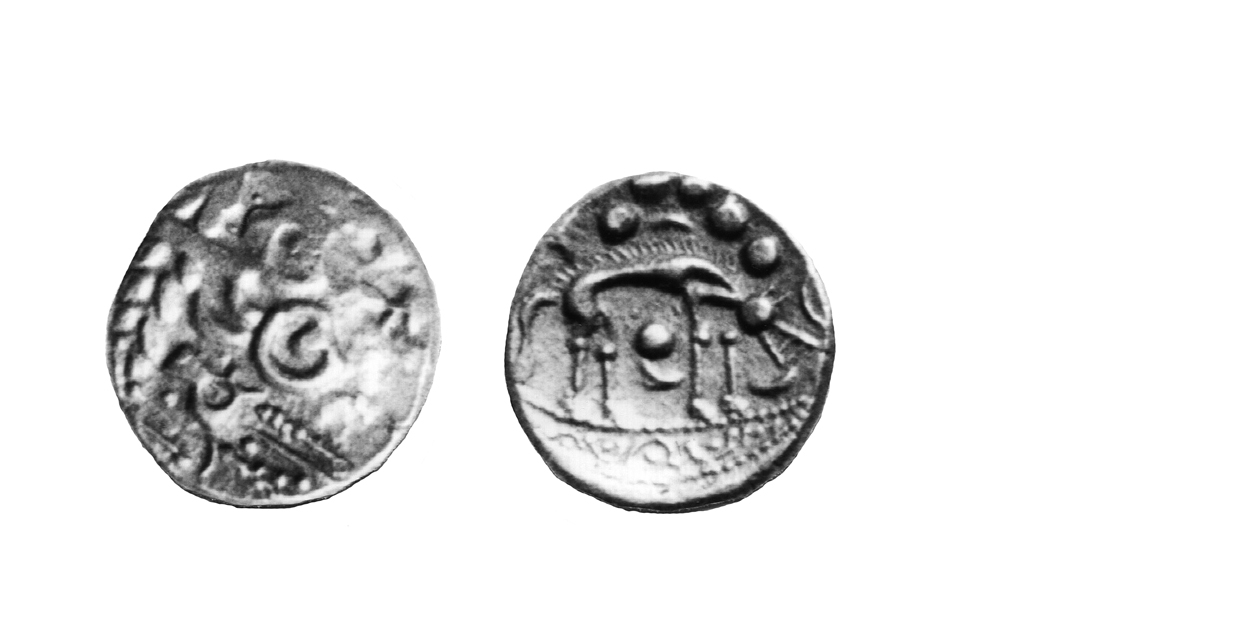
610 - 01 Norfolk Wolf Type
55-15 B.C. Scarce
Gold Stater 5.7-6.2 gms. 16 mm
Earliest Record: Evans, 1864
OBV: Abstracted head of Apollo right
Identifying points:
- laurel leaves upwards
REV: Wolf right
Identifying points:
- pellet and solid crescent below wolf
CLASSIFICATION: Icenian A
NOTES:
- Typical weight given
- Most are in museums
- Modern forgeries exist: 610 - 01F and 610 - 02F
- More comprehensive weight data now enable Taylor to place the start date for the earliest Norfolk Wolf types at 55 BC instead of 50 BC (Taylor 2017, p. 8)
(see 610-01F and 610-02F catalogue listings)
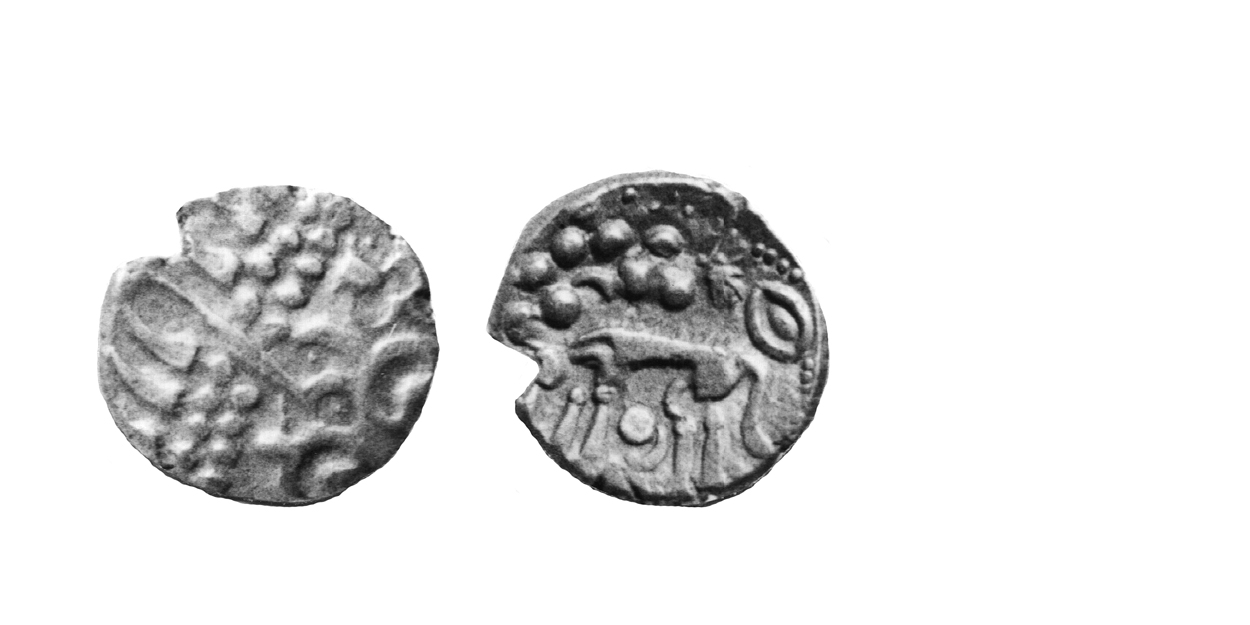
610 - 02 Norfolk Wolf Type
50-15 B.C. Very Rare
Gold Stater 5.7 6.2 gms. 17 mm
Earliest Record: Evans, 1864
OBV: Abstracted head of Apollo right
Identifying points:
- Laurel leaves downwards
REV: Wolf left
Identifying points:
- pellet and solid crescent below wolf
CLASSIFICATION: Icenian A
NOTES:
- Typical weight given
- Change in laurel leaves' direction may indicate a change in weight or metal content
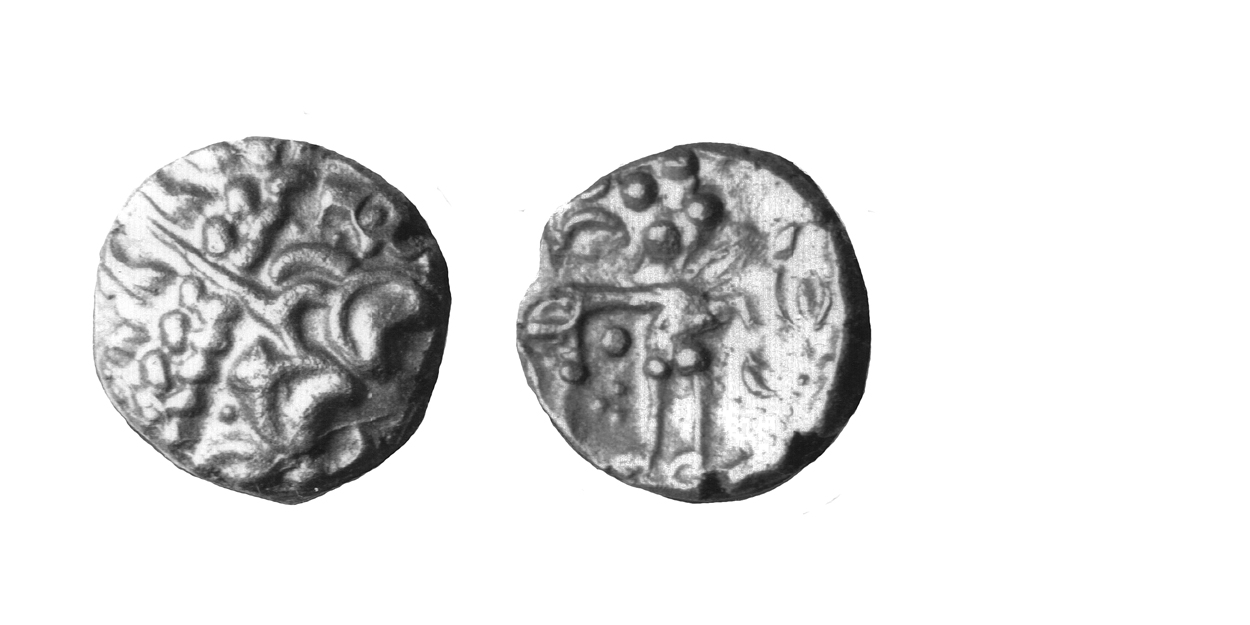
610 - 03 Norfolk Wolf Type
50-15 B.C. Common
Gold Stater 5.7-6.2 gms 17 mm
Earliest Record: Akerman 1837b
OBV: Abstracted head of Apollo right
Identifying points:
- laurel leaves downwards
REV: Wolf left
Identifying points:
- large pellet and triangular arrangement of three pellets below wolf
CLASSIFICATION: Icenian A
NOTES:
- Typical weight given
- Change in laurel leaves' direction may indicate a change in weight or metallic content
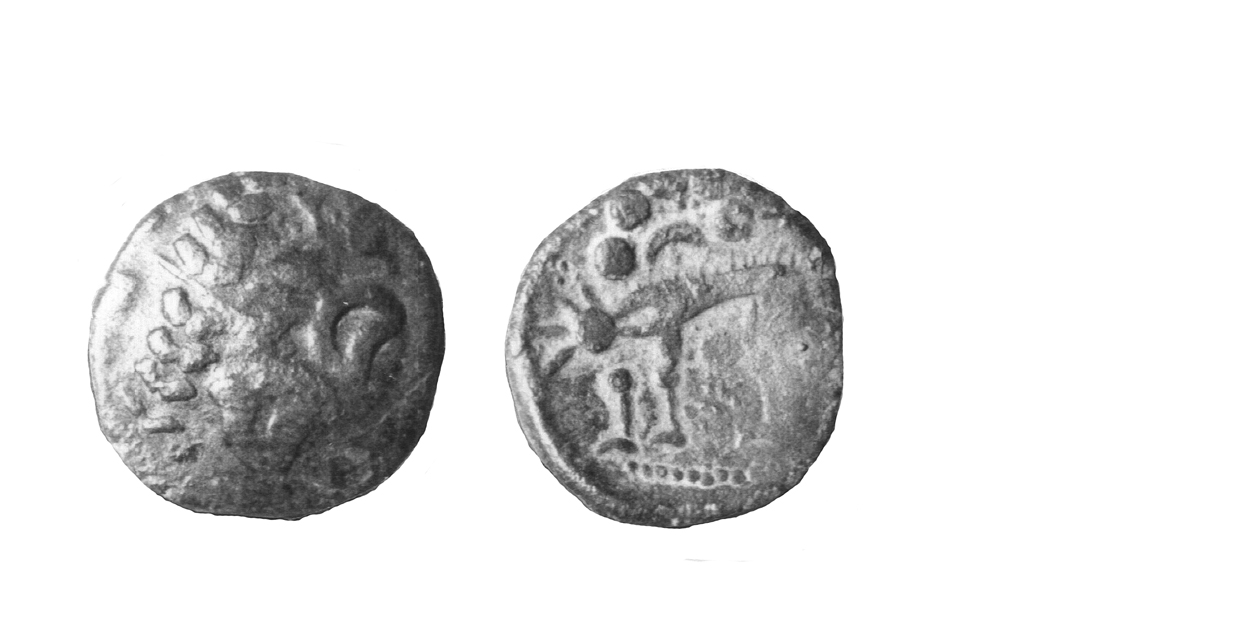
610 - 05 Norfolk Wolf Type
50-15 B.C. Very Rare
Gold/Bronze Plated Stater ca. 4.4 gms. 21 mm
Earliest Record: Van Arsdell, 1989
OBV: Abstracted head of Apollo right
Identifying points:
- as 610 - 03
REV: Wolf left
Identifying points:
- as 610 - 03
CLASSIFICATION: Icenian A
NOTES:
- Actual weight of illustrated coin given
- Ancient forgery
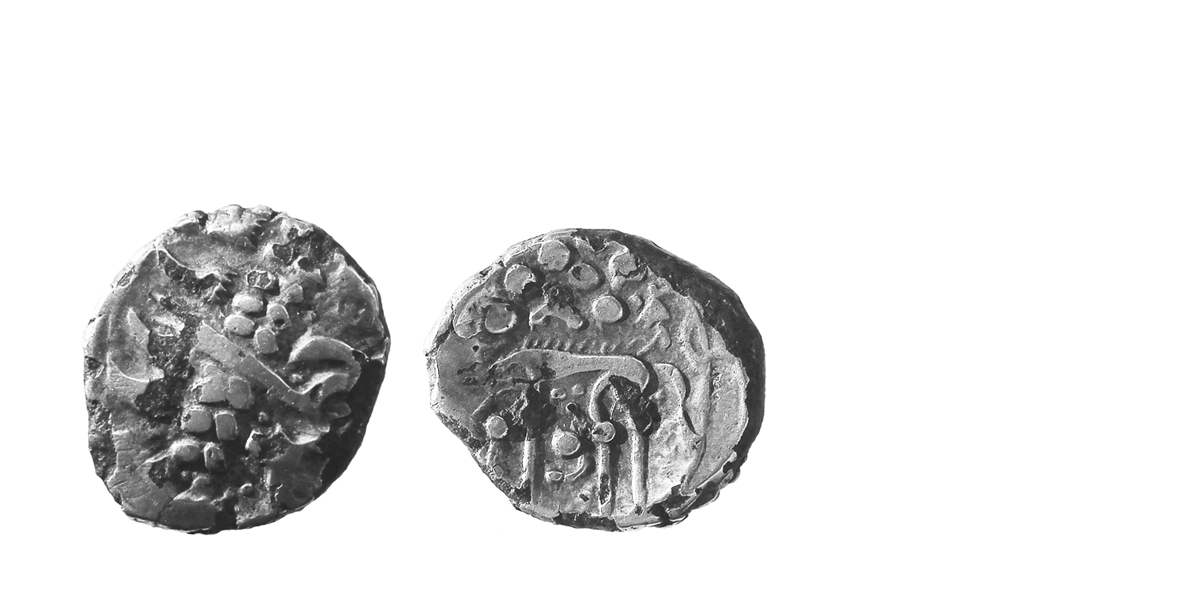
610 - 06 Norfolk Wolf Type
65-45 B.C. Extremely Rare
Gold/Bronze Plated Stater 4.37 gms. 20 mm
Earliest Record: Roth I sale, 1917 (Marks Tey find) Sotheby, Wilkinson and Hodge
OBV: Abstracted head of Apollo right
Identifying points:
- as 610 - 01
- laurel leaves upwards
REV: Wolf right
Identifying points:
- as 610 - 01
- pellet and solid crescent below wolf
CLASSIFICATION: Icenian A
NOTES:
- Ancient forgery
- Weight of illustrated coin given
- Illustrated coin is the Marks Tey find
- Allen, 1960 suggested it came from either the 1807 or 1843 hoards
- Recent work by de Jersey suggests the 1843 hoard is the source
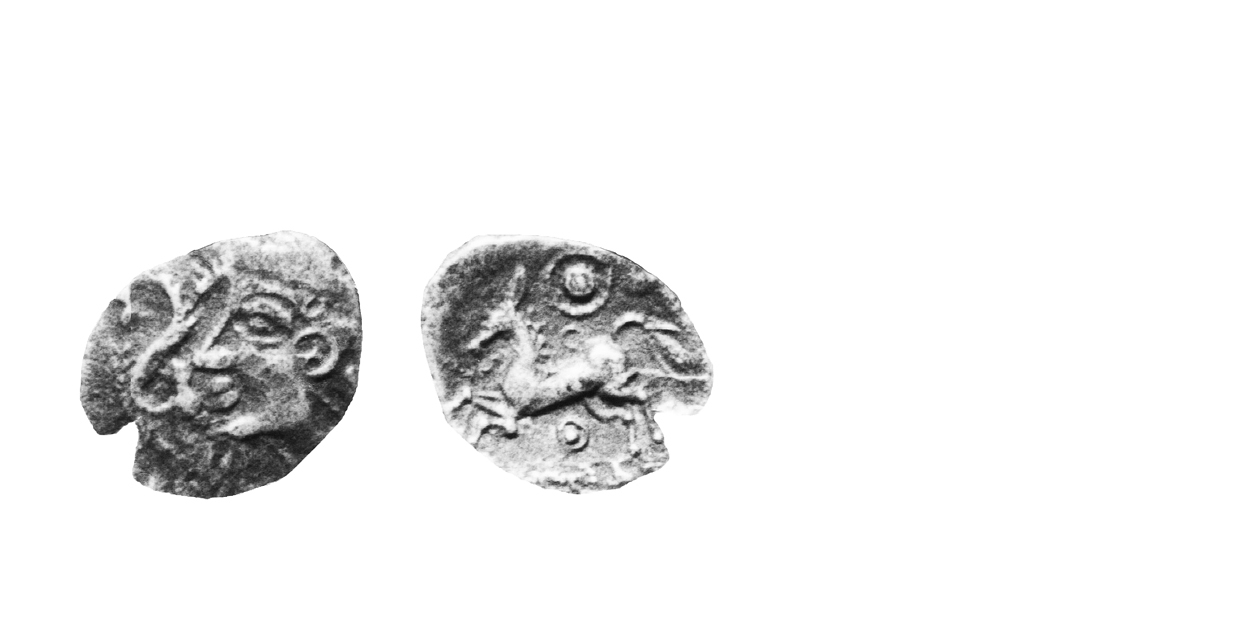
645 - 01 Bury Type A
50-15 B.C. Common
Silver Unit 1.50 gms. 14 mm
Earliest Record: Evans, 1864
OBV: Celticized head left
Identifying points:
- head wears diadem
- large reverse 'S' in front of face
REV: Celticized horse left
Identifying points:
- pellet-in-ring motif below horse
- large pellet in ring motif above horse
CLASSIFICATION: Icenian A
NOTES:
- Standard Weight given
- Typical weight 1.20 - 1.50 gms
- Dating follwos suggestions of John Talbot
- Allen described as British LX10
- Previously was 80 - 01 but John Talbot reports that large numbers of finds since 1989 demonstrate the type is British, not Continental, and should be assigned to the Iceni
- Reverse of Hosidius type of the Corieltauvi (855-03) derived from this coin
- Rarity now Common, as Talbot reports large numbers reported since 1989
(see catalogue listing for 855-03)
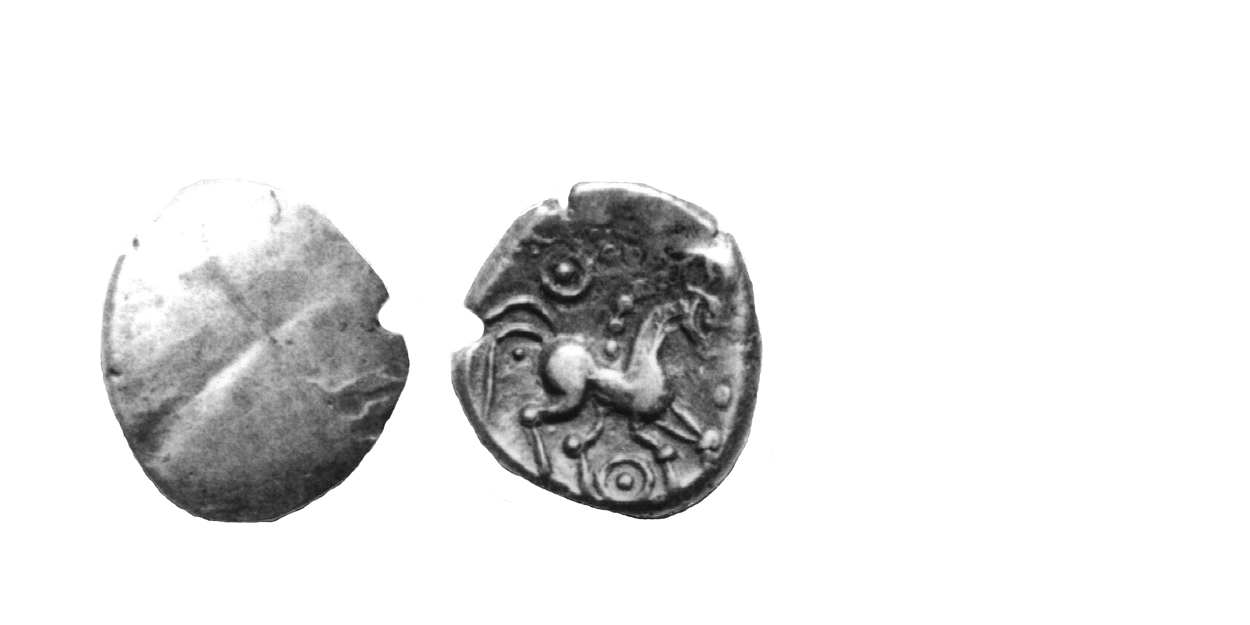
615 - 01 Snettisham Type
15 B.C.-5 A.D. Scarce
Gold Stater 5.4-5.9 gms. 16 mm
Earliest Record: Mack, 1953
OBV: Almost plain
Identifying points:
- slight traces of crossed wreaths possibly adapted from Middle Whaddon Chase Type
- cornucopia, or vestige of "wing" from Whaddon Chase Stater
- cornucopia opens in clockwise direction
REV: Romanized horse right
Identifying points:
- circle with pellet above horse
- circle with pellet below horse
- horse's tail made up of two lines
- four pellets above horse's neck
CLASSIFICATION: Icenian B
NOTES:
- Typical weight given
- Dating follows suggestions by John Talbot
- John Talbot now records additional examples of this type, reducing the Rarity from Very Rare to Scarce
- Many are in museums
- Previously attributed to the Trinovantes/Catuvellauni as a Late Whaddon Chase Type (1505 - 01), but now identified as an early Icenian issue by John Talbot

665 - 07 Snettisham Type
15 B.C. - 5 A.D. Rare
Silver Unit 1.05-1.25 gms. 13 mm
Earliest Record: Mack, 1964
OBV: Celticized head right
Identifying points:
- eye comprised of rectangular box with line in centre
- no ear
- 'coffee bean' for mouth
- hair comprised of herring-bone pattern of lines
REV: Celticized horse right
Identifying points:
- ring-and-pellet motifs above, below and in front of horse
- pellet below horse's tail
CLASSIFICATION: Icenian P
NOTES:
- Typical Weight given
- Dating follows suggestions by John Talbot
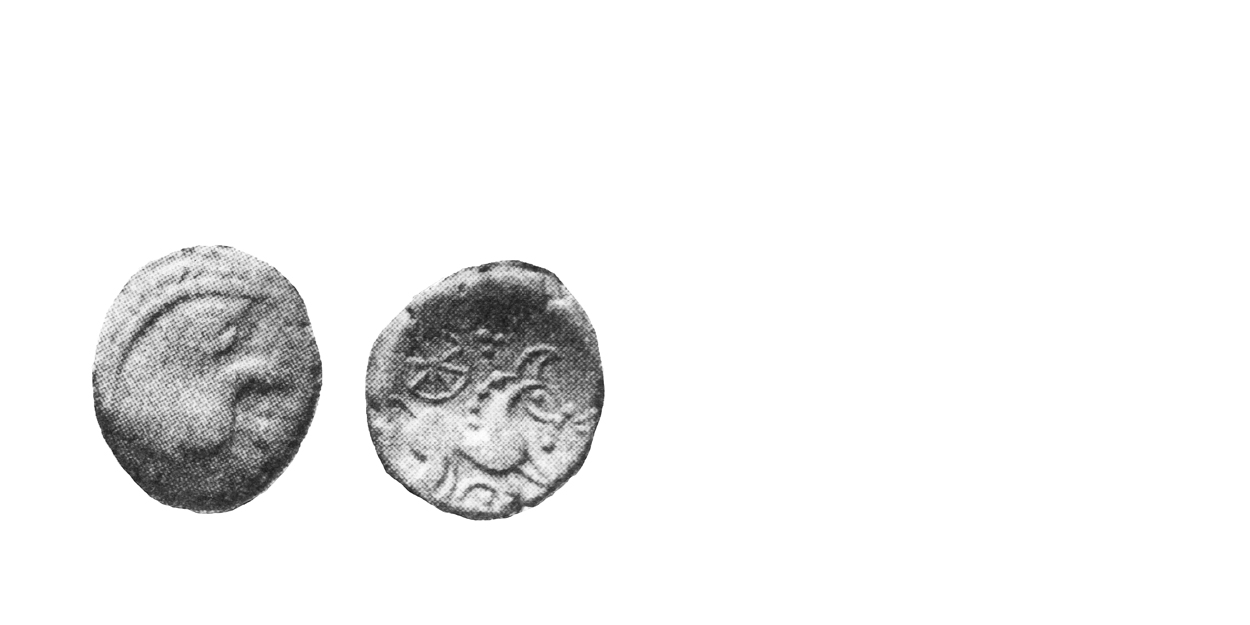
665 - 09 Snettisham Type
15 B.C. - 5 A.D. Extremely Rare
Silver Unit 1.05-1.25 Gms. 14 mm
Earliest Record: Mack, 1964
OBV: Celticized head right
Identifying points:
- Head indistinct, with little detail
REV: Celticized horse right
Identifying points:
- eight-spoked wheel above horse
- three pellets above horse's head
- ring, possibly with several pellets inside, below horse
CLASSIFICATION: Icenian E
Notes:
- Typical Weight given
- Dating follows suggestions by John Talbot
- This type has been conflated with 665 - 03 by some authors – See 665 - 03
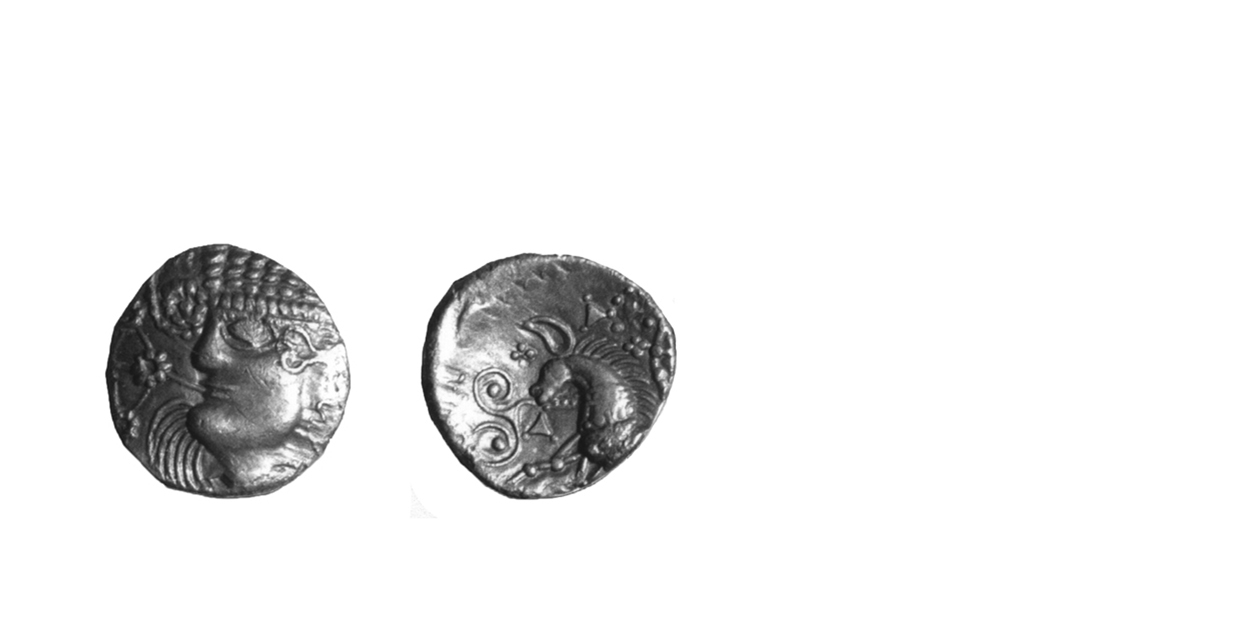
645 - 05 Bury Type F
50-15 B.C Extremely Rare
Silver Unit 13 mm
Earliest Record: Van Arsdell, 1989
OBV: Celticized head left
Identifying points:
- diadem
- elliptical eye
- flower on stem held in mouth
- heart-shaped ear
- beard made up of curved lines
REV: Celticized horse left
Identifying points:
- S-spiral held in mouth
- possibly a wheel above horse
- triangle and four pellets below head
- four pellets above head
CLASSIFICATION: Icenian A
Notes
- Dating follows suggestions of John Talbot
- Not enough reported weights to estimate Typical Weight
- Previously was Gallo-Belgic XD (V81-01)
- John Talbot has reassigned this silver unit to the Iceni as Bury Type F
Bury Type Silver Units
There is a wide variety of early Icenian Silver Units. John Talbot has grouped these into types, each with associated Gold Staters.
One major type is the Bury Type, with eight subgroups, each with minor die varieties. The Bury Type is believed to be associated with the Norfolk Wolf issues.
Of the eight Bury subgroups, designated A through F by Talbot, three are listed in this catalogue as representative. The catalogue numbers reserved for all of the subgroups (and any associated plated versions) are given in the following table. The Table lists the subgroups in the order given by Talbot (suggesting a possible chronological order).
| Subgroup | Silver Unit | Plated Unit | Comment | |
| Head Left: | ||||
| Bury A | 645-01 | 645-02 | Plated Unit reported | |
| Bury E | 645-03 | 645-04 | Plated Unit not reported | |
| Bury F | 645-05 | 645-06 | Plated Unit not reported | |
| Head Right: | ||||
| Bury C | 645-07 | 645-08 | Plated Unit not reported | |
| Bury H | 645-09 | 645-10 | Plated Unit not reported | |
| Bury D | 645-11 | 645-12 | Plated Unit not reported | |
| Bury G | 645-13 | 645-14 | Plated Unit not reported | |
| Bury B | 645-15 | 645-16 | Plated Unit reported | |
For a detailled discussion of these types, see Talbot 2017.
Earliest Icenian Silver Coins
The Icenian silver coinage, dating roughly from the Gallic War to the turn of the milennium, exhibits a wide variety of images. John Talbot (Talbot 2017) has studied this series in great detail and suggested groupings into types, subtypes and die-varieties.
The catalogue listings given here use Talbot's groupings to a great extent, but do not attempt to list all the minor subgroups and die-varieties. Researchers wanting to delve further into these coins are urged to consult Talbot's useful and detailed book.
It must be emphasized there is no corresponding study of modern forgeries that may exist. All researchers work diligently to eliminate fakes from the archaeological record. Unfortunately the continued appearance and publication of fakes in the Ancient British series makes one give pause. To overcome this problem, the listings in this catalogue have been done perhaps too conservatively, such that genuine types have have failed to be included. As authentication work catches up with basic research, further genuine types will be listed.
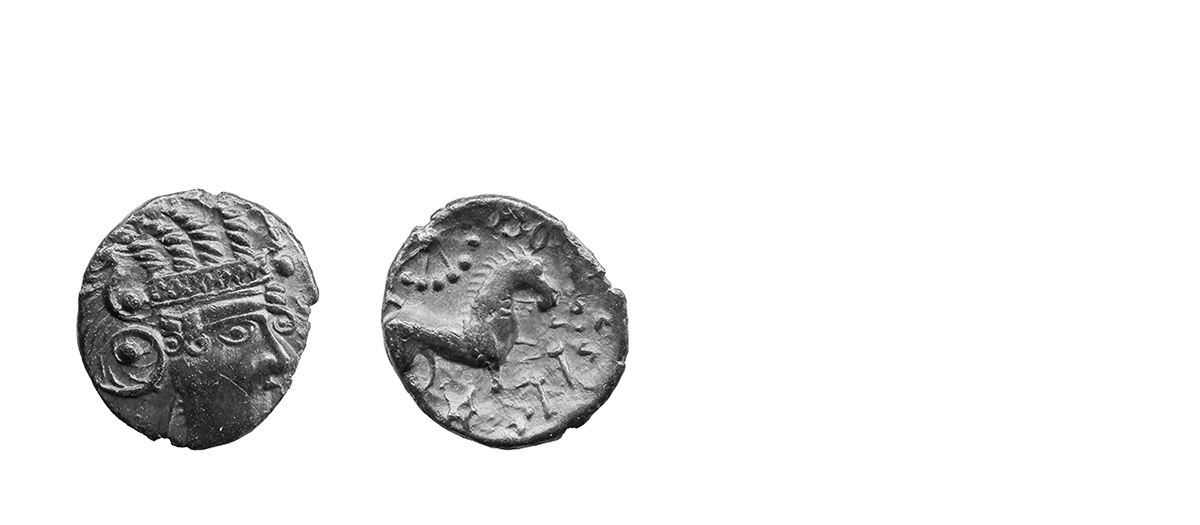
645 - 15 Bury Type B
50-15 B.C Common
Silver Unit 1.40 gms. 14 mm
Earliest Record: Gregory, 1992 (1989 lecture), Talbot, 2011
OBV: Celticized head right
Identifying points:
- head wears diadem
- elliptical eye
- large curl behind head
- small curl in front of brow
- five-pointed star with central hole in front of face
- no beard
REV: Celticized horse right
Identifying points:
- ellipse for ear
- large sunburst above horse
- five-pointed star with central hole below horse
- leaf-shaped tail
CLASSIFICATION: Icenian A
NOTES:
- Dating follows suggestions of John Talbot
- Standard Weight given
- John Talbot has assigned this silver unit to the Iceni as Bury Type B
- Obverse image adapted from Roman Republican Denarius
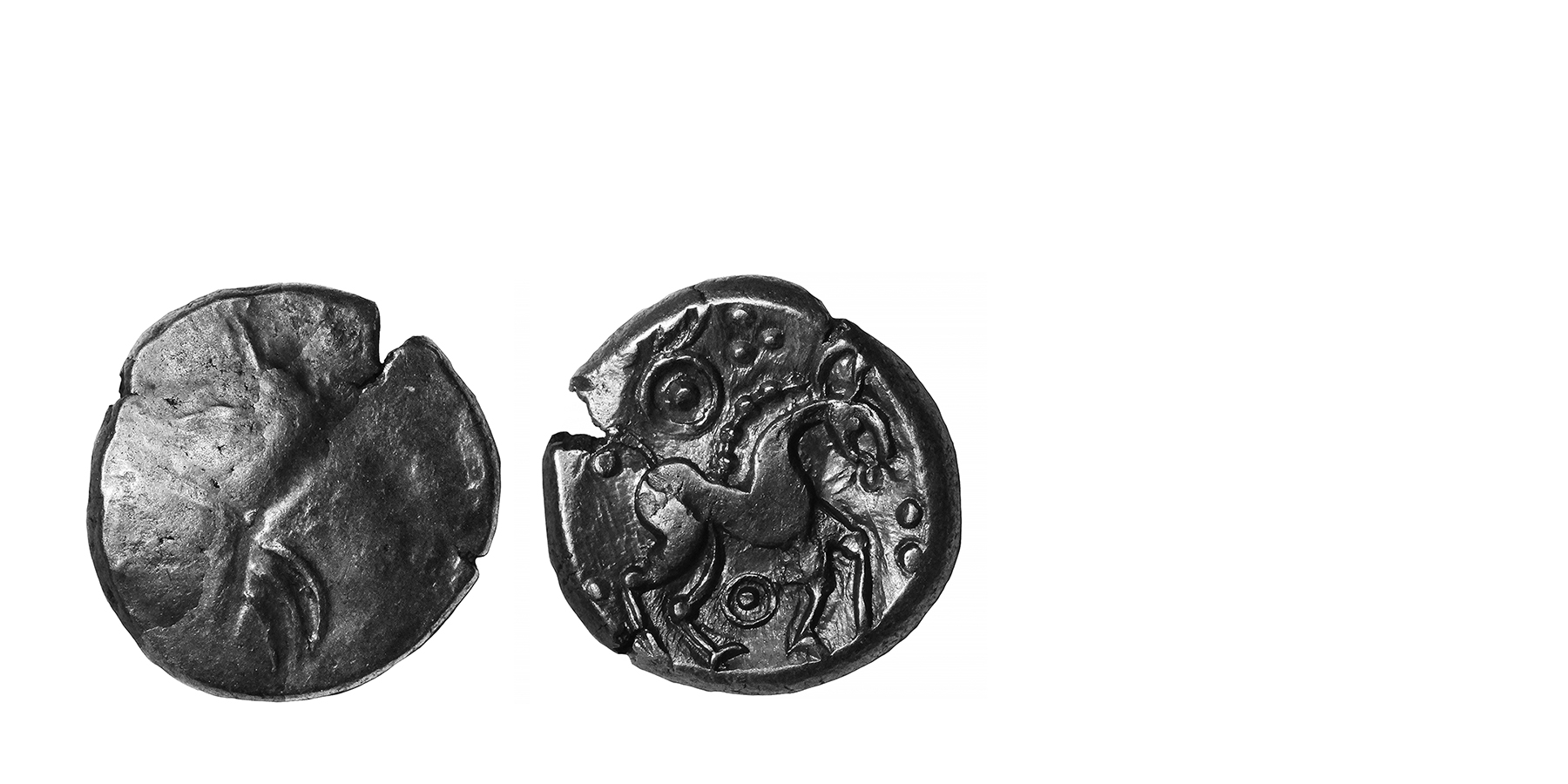
615 - 03 Snettisham Type
15 B.C.-5 A.D. Rare
Gold Stater 5.6 gms. 17 mm
Earliest Record: Van Arsdell 1990 (noted at trade exposition)
OBV: Almost plain
Identifying points:
- slight traces of crossed wreaths possibly adapted from Middle Whaddon Chase Type
- cornucopia, or vestige of "wing" from Whaddon Chase Stater
- cornucopia opens in counter-clockwise direction
REV: Romanized horse right
Identifying points:
- somewhat Romanized horse with head wishbone-shaped
- circle with pellet above horse
- circle with pellet below horse
- horse's tail made up of one line
- three pellets above horse's neck
CLASSIFICATION: Icenian B
NOTES:
- Typical weight given
- Dating follows suggestions by John Talbot
- Rarity estimated, this type is struck from fewer dies than V615-01
- Identified as an early Icenian issue by John Talbot
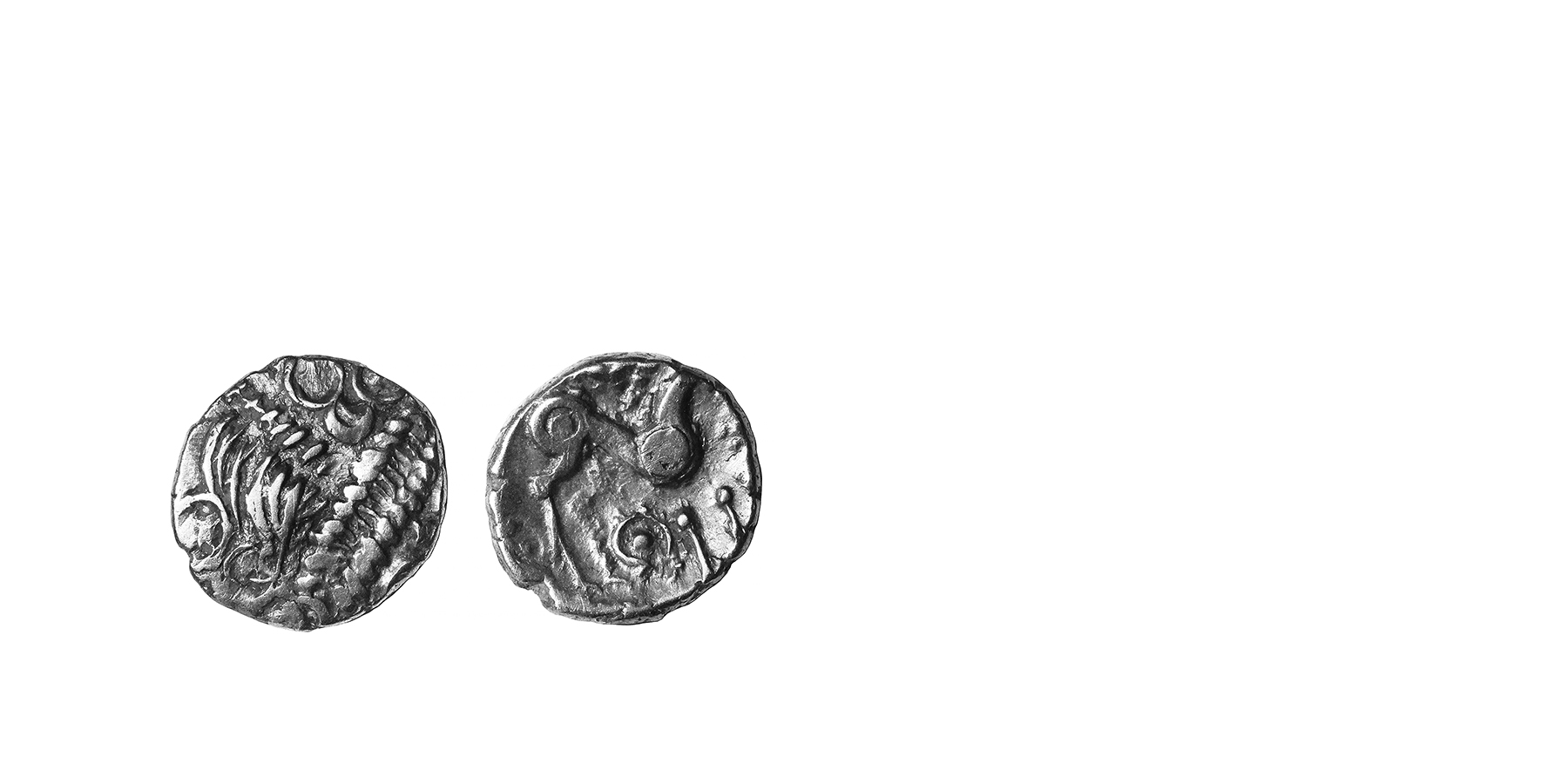
617 - 01 Snettisham Type
15 B.C.-5 A.D. Scarce
Gold Quarter Stater 1.2 gms. 11 mm
Earliest Record: Hobbs 1996, Talbot 2017
OBV: Complex wreath
Identifying points:
- wreath points upwards
- leaf elements connected by lines
- cornucopiae, or vestige of "wings" from Whaddon Chase Stater
- cornucopiae open in clockwise direction
REV: Romanized horse right
Identifying points:
- somewhat Romanized horse with head wishbone-shaped
- circle with pellet above horse
- circle with pellet below horse
- horse's tail made up of one line
- large pellet pellet motifs on horse's breast and rump
CLASSIFICATION: Icenian B
NOTES:
- Typical weight given
- Dating follows suggestions by John Talbot
- Rarity estimated, possibly commoner that reported
- Identified as an early Icenian issue by John Talbot
The Coinage of the Iceni
The Iceni occupied the area that is today Norfolk, Suffolk and parts of Cambridgeshire. Until the time of the Gallic War, the tribe seems economically isolated. Large Flan, Defaced Die and Abstract Design Type staters are not commonly found in Icenian territory, and presumably few were imported. Locally-made coins, the NORFOLK WOLF TYPE staters and BURY TYPE silver, were first produced late in the Gallic War. The earliest Icenian gold coinage comprises gold staters with the abstracted head of Apollo on the obverse and a disjointed wolf on the reverse. The heavy weight indicates the series began some time around the end of the war. After the war, the coins become quite debased and bronze cores of plated staters occur with some frequency. Later, a small coinage of SNETTISHAM TYPE coins were struck in gold and silver.
Apparently, extensive trading contacts developed during the war with the Trinovantes/Catuvellauni. A small number of Gallic War Type staters are found and uninscribed staters of the Trinovantes/Catuvellauni also appear. After the war, the coins of Addedomaros and Tasciovanus circulated. It is possible the Iceni relied on these imports instead of striking their own gold in volume.
About 20 B.C., the gold content of the Icenian coinage was restored with the introduction of the FRECKENHAM TYPE. Staters and quarters were struck lighter in weight to conform with the coinages of the other British tribes. The staters had a flower pattern or cross of pellets on the obverse and a Celticized horse on the reverse. Three major types occurred, described either as EARLIER and LATER, based on style and the progressive damage to one particular die linked with several others. Since all three types occurred in the Freckenham Hoard, it is likely they were contemporary.
After the war an extensive Icenian silver coinage was produced, which probably continued up to the time of the Boudiccan Rebellion. Silver units were produced to a standard weight of 1.25g. for nearly 100 years, a remarkable economic and technological achievement. There was a bewildering succession of types, subtypes and minor die varieties. These varieties have been systematically analyzed by John Talbot, and the arrangement is now reasonably certain. It appears that in any given period, three separate kinds of silver were being struck. Talbot suggests that the main Icenian mint either had two branch mints, or alternatively three workshops within a single mint. It is also possible that the different kinds of silver were either produced for different purposes, or perhaps at different times within a given period. Generally, the absolute chronology needs additional work. The chronology used here makes use of the work reported in John Talbot and Ian Leins's 2010 paper in The British Numismatic Journal.
The FRECKENHAM TYPE disappeared by 20 A.D. and the uninscribed silver coins were superseded by the dynastic. Very few inscribed gold coins are known. It is possible the gold coinage was minimal and the Iceni used silver coins augmented with Trinovantian/Catuvellaunian gold after 20 A.D. The Icenian dynastic period is largely one of a prolific silver coinage, beginning with the addition of an inscriptions to the CRESCENT TYPE and the introduction of the EMBLEM TYPE.
Most of the major types are listed here, but some of the minor issues need to be added. The dating of the various issues is controversial and that offered is somewhat arbitrary, based on die studies, typological sequences and analyses of coin hoards deposited around the rebellion of 61 A.D.
